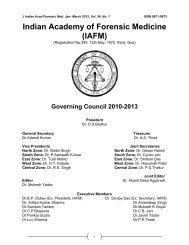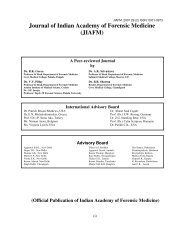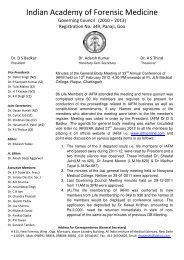Indian Academy of Forensic Medicine (IAFM) - Official website of IAFM
Indian Academy of Forensic Medicine (IAFM) - Official website of IAFM
Indian Academy of Forensic Medicine (IAFM) - Official website of IAFM
You also want an ePaper? Increase the reach of your titles
YUMPU automatically turns print PDFs into web optimized ePapers that Google loves.
J <strong>Indian</strong> Acad <strong>Forensic</strong> Med. October- December 2011, Vol. 33, No. 4 ISSN 0971-0973<br />
diseases and the dentist is expected to advise<br />
as needed. However in an <strong>Indian</strong> scenario due<br />
to lack <strong>of</strong> infrastructure, there is limited access<br />
to radiological equipments like CT scan, MRI<br />
etc. Under such conditions, the importance <strong>of</strong><br />
having a proper clinical history and thorough<br />
medical examination can never be undermined.<br />
In the above mentioned case, the concerned<br />
dentist neither took a proper clinical history or<br />
did a thorough clinical examination nor advised<br />
any routine investigation even though the patient<br />
presented with Grade III mobility <strong>of</strong> the tooth<br />
without any known etiology. Dental x-rays along<br />
with blood investigations like Hb%, BT, CT are<br />
important screening tests to detect<br />
hematological disorders and should have been<br />
advised before starting the dental extraction.<br />
In view <strong>of</strong> history, examination &<br />
investigations for proper diagnosis & treatment<br />
<strong>of</strong> patient, several authors have devised various<br />
protocols that can be followed before starting<br />
any dental procedure. The advantage <strong>of</strong> having<br />
a definite standard protocol is that the whole<br />
process <strong>of</strong> diagnosis and treatment becomes<br />
systematized resulting in better patient care and<br />
less errors on the part <strong>of</strong> the doctor. Peterson et<br />
al had devised a protocol that may be followed<br />
before tooth extraction: [2]<br />
1. Biographic Data: Name, Address, Age, Sex,<br />
Occupation & marital status etc are<br />
obtained.<br />
2. Chief complaint and history:<br />
3. Medical History: Any history <strong>of</strong> relevant<br />
diseases [Rheumatic heart disease, heart<br />
abnormalities, diabetes, liver diseases,<br />
tuberculosis, kidney trouble] are elicited.<br />
4. Social and family medical histories:<br />
Prevalence <strong>of</strong> relevant diseases in the<br />
family, their socio economic status, any<br />
health related habits or addictions etc are to<br />
be investigated.<br />
5. Review <strong>of</strong> systems: Different systems <strong>of</strong><br />
body are to be examined to reveal<br />
undiagnosed medical conditions unknown to<br />
patient.<br />
6. Physical examination <strong>of</strong> oral cavity & entire<br />
maxill<strong>of</strong>acial region is to be done.<br />
7. Laboratory and radiographic examinations.<br />
In this case, radiological studyhave<br />
shown little or no change, but CT scan may<br />
show the shape, extent & boundaries <strong>of</strong> lytic<br />
expansion <strong>of</strong> intraosseous AVM. [1, 3] MR<br />
study would have been best employed for<br />
characteristics <strong>of</strong> the lesion. [4] Angiography is<br />
currently the gold standard for determination <strong>of</strong><br />
location and flow characteristics <strong>of</strong> vascular<br />
lesions. [5]<br />
For management <strong>of</strong> small AVMs,<br />
surgeons advocate embolization <strong>of</strong> feeder<br />
371<br />
vessels in combination with intraosseous inj. <strong>of</strong><br />
embolizing agents to permanently obliterate the<br />
lesion[6]. For large AVM, maxillectomy or<br />
mandibulectomy is the treatment <strong>of</strong> choice even<br />
though it is associated with significant<br />
disfigurement <strong>of</strong> the face. [7] If the patient<br />
presents with massive bleeding during extraction<br />
or post – extraction, local measures like digital<br />
pressure with gauze, bone wax etc are applied.<br />
If bleeding fails to stop, surgical ligation <strong>of</strong> the<br />
main feeder vessel (lingual, facial, internal<br />
maxillary or external carotid artery) is done.<br />
Legal issues pertaining to such kind <strong>of</strong><br />
cases:<br />
In this case, doctor could be charged for<br />
negligence under Sec 304A IPC, in case <strong>of</strong><br />
complaint. Sec 304A IPC states ―Whoever<br />
causes the death <strong>of</strong> any person by doing any<br />
rash or negligent act not amounting to culpable<br />
homicide, shall be punished with imprisonment<br />
<strong>of</strong> either description for a term which may extend<br />
to two years, or with fine, or with both‖[8].<br />
Conclusion:<br />
Though dental extraction is considered<br />
to be a minor surgical procedure, a few cases<br />
may present with life threatening complications<br />
including hemorrhage. Careful & relevant history<br />
taking, physical and dental examinations prior to<br />
dental procedures are a must to avoid<br />
intraoperative and post operative complications.<br />
Oral & maxill<strong>of</strong>acial surgeon plays a<br />
crucial role in diagnosing & managing these<br />
emergencies in ED. Active bleeding which<br />
cannot be controlled by local measures in the<br />
dental <strong>of</strong>fice should be referred to the nearest<br />
hospital ED so that the airway can be secured<br />
and the hemorrhage managed appropriately.<br />
References:<br />
1.Niimi Y, Song JK, Berenstein A. Current Endovascular Management<br />
<strong>of</strong> Maxill<strong>of</strong>acial Vascular Malformations. Neuroimag Clin N Am<br />
2007; 17: 223 – 237.<br />
2.Peterson LJ, Ellis Edward, Hupp JR et al. Preoperative Health Status<br />
Evaluation. Contemporary Oral and Maxill<strong>of</strong>acial Surgery. 4th Ed,<br />
pp 2 – 10. Elsevier India, 2003.<br />
3.Sakkas N, Schramm A, Metzger MC et al. Arteriovenous malformation<br />
<strong>of</strong> the mandible: A life – threatening situation. Ann Hematol 2007;<br />
86: 409-13.<br />
4.Remonda L, Schroth G, Ozdoba C et al. Facial Intraosseous<br />
Arteriovenous Malformations: CT and MR features. J. Comput.<br />
Assist. Tomogr. 1995; 19(2): 277 – 81.<br />
5.Kademani D, Costello BJ, Ditty D et al. An alternative approach to<br />
Maxill<strong>of</strong>acial Arteriovenous Malformations with transosseous Direct<br />
Puncture Embolization. Oral Surg Oral Med Oral Pathol Oral Radiol<br />
Endod 2004; 97: 701 – 6.<br />
6.Siu WW, Weill A, Gariepy JL et al. Arteriovenous Malformation <strong>of</strong> the<br />
Mandible: Embolization and Direct Injection Therapy. J Vasc Interv<br />
Radiol 2006; 12(9): 1095 – 98.<br />
7.Kacker A, Heier L, Jones J. Large Intraosseous Arteriovenous<br />
Malformation <strong>of</strong> the Maxilla – A case report with review <strong>of</strong> literature.<br />
Int J Pedia Otorhinolaryngol 2000; 52: 89 – 92.<br />
8. Mallick M. Criminal Manual. pp 137. New Delhi: Pr<strong>of</strong>essional Book<br />
Publications, 2004.









